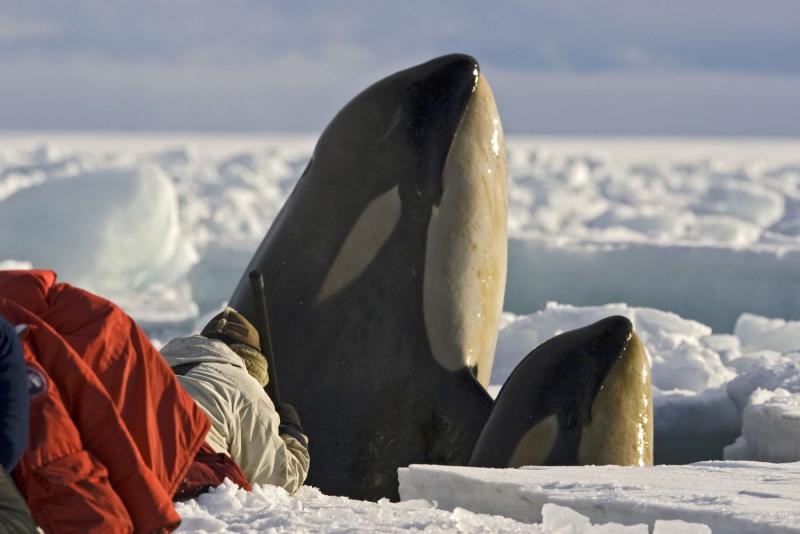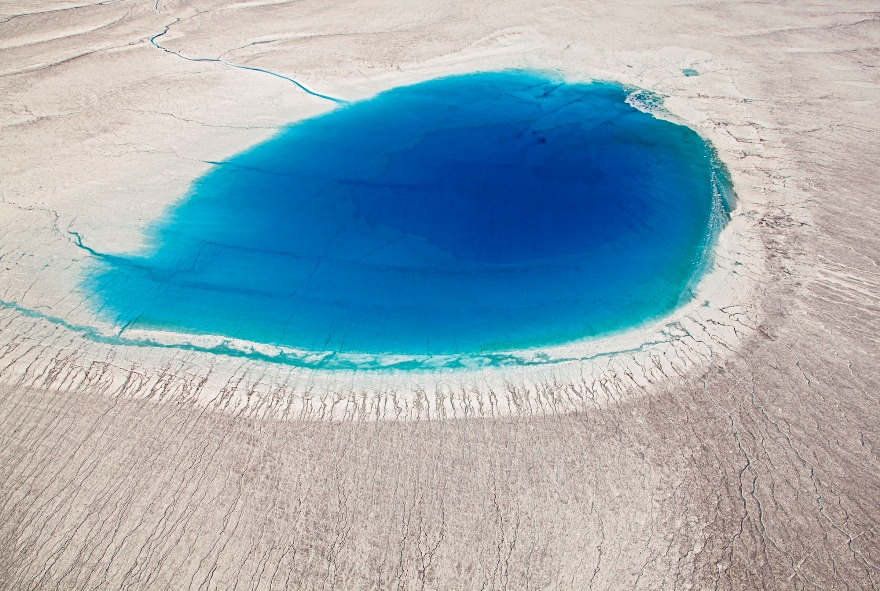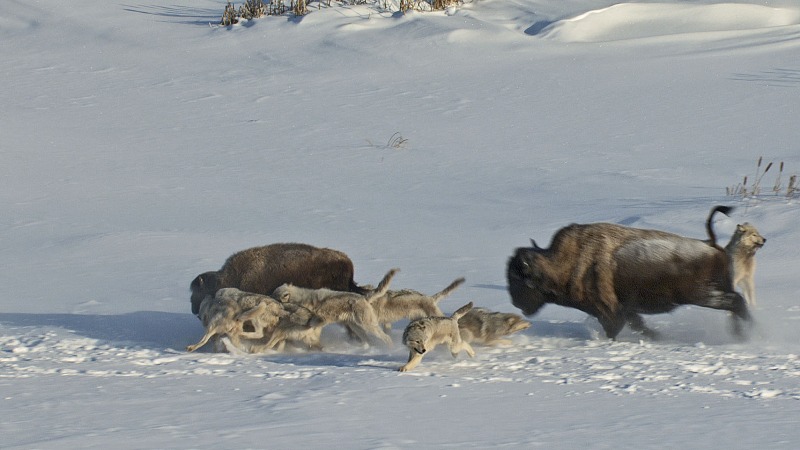Frozen Planet, BBC One | reviews, news & interviews
Frozen Planet, BBC One
Frozen Planet, BBC One
Breathtaking camerawork and David Attenborough are two reasons to take this unmissable trip to the ends of the Earth

It’s been suggested that, come the revolution, the best possible of outcomes to the question of who shall be Head of State is the man off the goggle box who for innumerable aeons has been telling us about the birds and the bees, the silverbacks and the dung beetles, the fishes and the flytraps. But could we not, on reflection, do a bit better than that? If God does exist he is surely the spit of David Attenborough.
If you did not watch Frozen Planet, you must. If you did last night, you will be planning to watch it again, and again, possibly till the end of time (which thanks to global warming is, of course, sooner than we like to think). Attenborough for the most part lent his larynx on this one, supplying the ne plus ultra of to-camera top-and-tail monologues: he started at the North Pole and ended at the South Pole. The coldest regions of Earth, he explained, tend to bring out the superlatives. Thus we made the acquaintance of the fastest-flowing glacier, the biggest land mass, the biggest land predator, the fastest winds, the highest, driest and coldest territory on Earth - all thanks to another superlative: the most magnificent photography.
 The mountains of Antarctica, so often visualised in the Edwardian explorer's understated journal, rose up before your eyes. Here was a helicopter shot of the hideously slotted Beardmore Glacier up which Scott and his men miraculously schlepped. In Greenland, melt lakes (pictured right; image by Vanessa Berlowitz) overflowed, causing rivers to cut across the polar cap before plunging to the depths of the mile-thick ice. Bergs calved off the edge of glaciers and clattered spectacularly into the sea.
The mountains of Antarctica, so often visualised in the Edwardian explorer's understated journal, rose up before your eyes. Here was a helicopter shot of the hideously slotted Beardmore Glacier up which Scott and his men miraculously schlepped. In Greenland, melt lakes (pictured right; image by Vanessa Berlowitz) overflowed, causing rivers to cut across the polar cap before plunging to the depths of the mile-thick ice. Bergs calved off the edge of glaciers and clattered spectacularly into the sea.
It would be lovely to know that Roland Emmerich and James Cameron and Tinseltown’s various deities of CGI and 3D who fake up this stuff to line their pockets at the expense of gullible teenagers in multiplexes in Wisconsin might see these jaw-dropping images and blush. Yes, there is a modest amount of fakery. Thanks to the new facility of time-lapse photography, a camera can be parked in the wilderness for half a year and its film sped up to show a glacier heaving and convulsing at high speed like a regular river. The sea can freeze and melt, the sun rise and, six months later, fall at the press of a fast-forward button.
 But most of the footage is the product of supreme perseverance. The photographers, too myriad to mention, froze their bits off - clambering to the top of Mount Erebus, diving under the sea ice - to acquire the images of wildlife at these latitudes as they’ve rarely (or sometimes) never been seen before. In the north, male polar bears fought gladiatorially over a female, who submitted herself to the bloodied victor. Bison fended off a pack of wolves until one murderously clattered another into the ground in a frantic bid to escape (pictured above left). In the south, a pod of killer whales hunted a seal by collectively causing a wave motion to dislodge it from an ice floe. A sea lion chasing a penguin, but on land, where each moved in comical, slow-motion inefficiency.
But most of the footage is the product of supreme perseverance. The photographers, too myriad to mention, froze their bits off - clambering to the top of Mount Erebus, diving under the sea ice - to acquire the images of wildlife at these latitudes as they’ve rarely (or sometimes) never been seen before. In the north, male polar bears fought gladiatorially over a female, who submitted herself to the bloodied victor. Bison fended off a pack of wolves until one murderously clattered another into the ground in a frantic bid to escape (pictured above left). In the south, a pod of killer whales hunted a seal by collectively causing a wave motion to dislodge it from an ice floe. A sea lion chasing a penguin, but on land, where each moved in comical, slow-motion inefficiency.
You can make a desultory effort to pick holes. If it's science, it's the Reader's Digest version. While the polar bears were shagging, they might have soft-pedalled the Seventies porn mood music. Perhaps a little more explanation of why, as was claimed, the weather at the poles impacts on the rest of us would have helped. You’d quite like to know why and how crevasses open up. I have a still-lingering suspicion about the storyboarding of animal narratives - do they really do everything in the edited order? - but so total is the access afforded by high-definition cameras shooting from helicopters or light aircraft that it’s much easier to believe these things happen pretty much as presented. However, this is masterpiece television, at which you can do no more than gasp and gawp, high-five and huzzah, go down on your knees and give thanks for the licence fee.
rating
Explore topics
Share this article
Add comment
The future of Arts Journalism
You can stop theartsdesk.com closing!
We urgently need financing to survive. Our fundraising drive has thus far raised £49,000 but we need to reach £100,000 or we will be forced to close. Please contribute here: https://gofund.me/c3f6033d
And if you can forward this information to anyone who might assist, we’d be grateful.

Subscribe to theartsdesk.com
Thank you for continuing to read our work on theartsdesk.com. For unlimited access to every article in its entirety, including our archive of more than 15,000 pieces, we're asking for £5 per month or £40 per year. We feel it's a very good deal, and hope you do too.
To take a subscription now simply click here.
And if you're looking for that extra gift for a friend or family member, why not treat them to a theartsdesk.com gift subscription?
more TV
 Blu-ray: The Sweeney - Series One
Influential and entertaining 1970s police drama, handsomely restored
Blu-ray: The Sweeney - Series One
Influential and entertaining 1970s police drama, handsomely restored
 I Fought the Law, ITVX review - how an 800-year-old law was challenged and changed
Sheridan Smith's raw performance dominates ITV's new docudrama about injustice
I Fought the Law, ITVX review - how an 800-year-old law was challenged and changed
Sheridan Smith's raw performance dominates ITV's new docudrama about injustice
 The Paper, Sky Max review - a spinoff of the US Office worth waiting 20 years for
Perfectly judged recycling of the original's key elements, with a star turn at its heart
The Paper, Sky Max review - a spinoff of the US Office worth waiting 20 years for
Perfectly judged recycling of the original's key elements, with a star turn at its heart
 The Guest, BBC One review - be careful what you wish for
A terrific Eve Myles stars in addictive Welsh mystery
The Guest, BBC One review - be careful what you wish for
A terrific Eve Myles stars in addictive Welsh mystery
 theartsdesk Q&A: Suranne Jones on 'Hostage', power pants and politics
The star and producer talks about taking on the role of Prime Minister, wearing high heels and living in the public eye
theartsdesk Q&A: Suranne Jones on 'Hostage', power pants and politics
The star and producer talks about taking on the role of Prime Minister, wearing high heels and living in the public eye
 King & Conqueror, BBC One review - not many kicks in 1066
Turgid medieval drama leaves viewers in the dark
King & Conqueror, BBC One review - not many kicks in 1066
Turgid medieval drama leaves viewers in the dark
 Hostage, Netflix review - entente not-too-cordiale
Suranne Jones and Julie Delpy cross swords in confused political drama
Hostage, Netflix review - entente not-too-cordiale
Suranne Jones and Julie Delpy cross swords in confused political drama
 In Flight, Channel 4 review - drugs, thugs and Bulgarian gangsters
Katherine Kelly's flight attendant is battling a sea of troubles
In Flight, Channel 4 review - drugs, thugs and Bulgarian gangsters
Katherine Kelly's flight attendant is battling a sea of troubles
 Alien: Earth, Disney+ review - was this interstellar journey really necessary?
Noah Hawley's lavish sci-fi series brings Ridley Scott's monster back home
Alien: Earth, Disney+ review - was this interstellar journey really necessary?
Noah Hawley's lavish sci-fi series brings Ridley Scott's monster back home
 The Count of Monte Cristo, U&Drama review - silly telly for the silly season
Umpteenth incarnation of the Alexandre Dumas novel is no better than it should be
The Count of Monte Cristo, U&Drama review - silly telly for the silly season
Umpteenth incarnation of the Alexandre Dumas novel is no better than it should be
 The Narrow Road to the Deep North, BBC One review - love, death and hell on the Burma railway
Richard Flanagan's prize-winning novel becomes a gruelling TV series
The Narrow Road to the Deep North, BBC One review - love, death and hell on the Burma railway
Richard Flanagan's prize-winning novel becomes a gruelling TV series
 The Waterfront, Netflix review - fish, drugs and rock'n'roll
Kevin Williamson's Carolinas crime saga makes addictive viewing
The Waterfront, Netflix review - fish, drugs and rock'n'roll
Kevin Williamson's Carolinas crime saga makes addictive viewing

Comments
An absolute masterpiece.